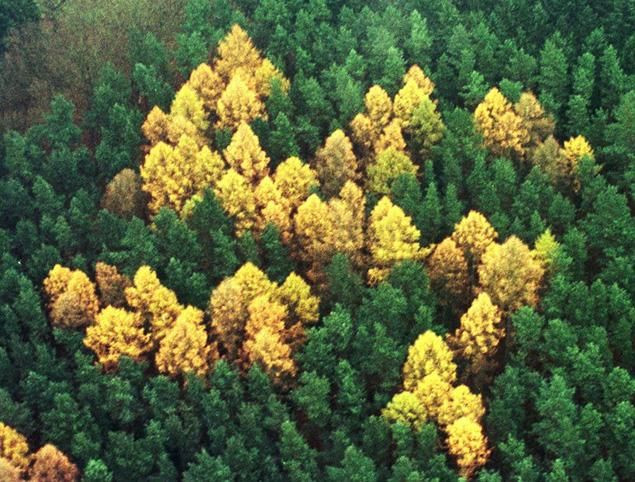Forest Swastikas: Larch Trees In Bradenburg, Germany Forest Resemble Nazi Party Symbol [PHOTO]

A forest in Bradenburg, Germany, possesses a group of trees that grew into the shape of a swastika, the symbol of Adolf Hitler’s infamous political party.
Okoland Dederow, an intern at a German landscaping company, was poring over aerial photos of a Bradenburg forest when he noticed that formations of larch trees had formed "forest swastikas," a new retrospective by Der Spiegel, a German news outlet, reports. The forest swastikas weren’t discovered until 1992, nearly 60 years after the larch trees were planted.
According to Der Spiegel, the Bradenburg forest swastika stands 200 feet by 200 feet, with a group of larch trees interspersed among pine trees. The insidious design is visible only in the fall, when the larch trees turn yellow and orange amid the green pines.
A local forester determined that the forest swastika was originally planted in the late 1930s, a period during which the Nazi Party’s power was at its zenith in Germany. The covert formation of trees escaped notice for the next several decades, through the rise of communism in East Germany and the fall of the Berlin Wall.
Brandenburg residents have developed several possible theories on the origin of the forest swastikas, Der Spiegel reports. One local farmer claims to have planted the larch trees as a child, while others insist that the forest swastika was planted as a sign of obeisance after a local villager was dragged off by the Nazis for listening to the BBC. The Berliner Zeitgun newspaper eventually reported that the trees were planted to thank the Reich Labor Service for constructing a road in Zernikow, but the forest swastikas’ true origin has yet to be verified.
Authorities in Bradenburg weren’t thrilled by the notion of Nazi symbolism in a local forest. In 1995, forestry workers used chainsaws to cut down dozens of the suspect larch trees, but the effort failed to adequately disrupt the massive swastika formation, Der Spiegel reports.
Five years later, Bradenburg’s agriculture ministry planned to cut down all of the remaining trees, citing fears that the forest site would become a rally point for neo-Nazi elements. However, a dispute over property ownership forced the plan to be scaled back, and only 25 of the larch trees were cut down.
The Bradenburg forest swastika isn’t the only dubious remnant of its kind. In the 1970s, American soldiers reported finding a swastika growing in a spruce forest in the Hesse region of Germany. In 2006, a similar growth was found in a forest in Kyrgystan.
© Copyright IBTimes 2024. All rights reserved.






















